Serviços Personalizados
Artigo
Indicadores
Links relacionados
-
 Citado por Google
Citado por Google -
 Similares em Google
Similares em Google
Compartilhar
Stellenbosch Papers in Linguistics Plus (SPiL Plus)
versão On-line ISSN 2224-3380
versão impressa ISSN 1726-541X
SPiL plus (Online) vol.62 Stellenbosch 2022
http://dx.doi.org/10.5842/62-0-898
ARTICLES
The grammatical primacy of tone in Cushitic
Maarten Mous
Centre for Linguistics, Leiden University, Netherlands. E-mail: m.mous@hum.leidenuniv.nl
ABSTRACT
The current dimensions in the typology of tone are not insightful for understanding the properties of tone in Cushitic languages. Some Cushitic languages are characterised as "pitch accent", but these cannot be considered stress languages because the criterion of obligatoriness of every word having a stressed unit is not valid for them. In Hyman's (2006) typology, these languages are (restricted) tone languages. Pitch as prominence marker does show the stress-like tendencies of culminativity and demarcation in these languages, which is why the label "pitch accent" has been suggested. The tone properties are better explained by another dimension, namely the fact that the distinctive function of tone hardly plays a role at the lexical level but does play a role at the grammatical level.
Keywords: Cushitic; tone; accent; stress; morphology; typology
1. The issue
The aim of this article is to suggest that some properties of prominence of some Cushitic languages are better understood if one takes into account whether tone in a language functions only grammatically and not lexically against the more common situation that tone serves both functions. This is not a proposal to revise prosodic typology, which is by necessity phonological in nature; rather, I wish to emphasise how morphological typology, such as predominantly suffixing, in combination with the situation of tone being distinctive in grammatical morphemes only (or mainly) can result in properties of preponderance of culminativity and demarcation without the property of obligatoriness. Hence these restricted tone languages show some stress-like features because their restriction lies in tone in grammatical morphemes, but not in lexical morphemes, while they remain fundamentally non-stress, since (most) lexical items are without stress.
There is some controversy over whether Cushitic languages have tone or accent. Hayward (1991) argues for tone in Afar, Owens (1980) likewise for Oromo, Hetzron (1997: 483-489) and Joswig (2006) do so for Awngi, and Appleyard (1991) for Cushitic in general. Others argue for accent: Hudson (1973) for Beja, and Biber (1982) for Somali. And there is a sort of compromise using the "pitch accent" label as proposed by Hyman (1981) for Somali, and Banti (1988) for Oromo and Somali, or for a system which is underlyingly accentual but tonal in realisation, as Pillinger (1988) proposes for Rendille. The properties of Cushitic languages are of interest to the discussion of tone against accent (Hyman 2006) but this discussion does not do justice to the peculiarities that many Cushitic languages share, such as:
(i) a minor role for tone/accent in the lexicon,
(ii) many lexical elements with no tone/accent, and
(iii) a high functional load for tone in grammar.
Following the suggestion by Sasse (1981: 205), I argue that these peculiarities are best captured if the presence or absence of functionality of lexical distinction is taken into account when characterising the prosodic typology. Tone/accent typology does not do justice to the main property for many of the Cushitic languages, namely that the function is primarily grammatical and, to a much lesser extent, lexical.
There are about 50 Cushitic languages, with most being spoken in the Horn of Africa - Eritrea, Ethiopia, Somalia, Kenya - and Tanzania. Overviews on Cushitic languages are available, for example, in Tosco (2000) and Mous (2012), and overviews on tone in Cushitic in Appleyard (1991) and Hayward (1991). The genetic tree is roughly [Beja [Agaw languages [Highland East Cushitic [Lowland East Cushitic] and South Cushitic somewhere within East Cushitic. The best-studied major languages such as Oromo, Somali, and Saho-'Afar are Lowland East Cushitic.
Overviews of Cushitic tone have already pointed to the following properties: tonal (pitch) in realisation but with accent-like distributional restrictions and the dominance of grammatical function over lexical distinction. Appleyard (1991) considers most if not all Cushitic languages to have tonal accent, with the mora as a locus of a high tone accent. He stresses the grammatical function of accent, as was already suggested by Sasse (1981: 205). Appleyard sees comparative evidence that Proto Lowland East Cushitic, and probably even higher levels in the Cushitic family tree, was a tone/accent language in which tone functioned in the inflectional system: -í subject case marker in Lowland East Cushitic, in gender distinction and in the jussive conjugation. He hypothesizes a distinctive role for tone/accent at the lexical level with root categories.
In the next section, 2, I discuss typologies of tone and the role of lexical distinctiveness in these definitions. Cushitic languages in which tone functions for grammar only fall under the current definition of a tone language (section 3) and do not qualify as a stress language. This is because they lack the crucial criterion of culminativity but nevertheless show tendencies toward culminativity (section 3.1) and show the stress-like tendency that prominence (tone) is limited to the edge of the word, i.e. demarcation (section 3.2). In section 3.3, I show that some of the tone rules in these Cushitic tone languages are different from those from more prototypical tone languages. In section 4, I briefly touch upon a number of ways in which tone gains more functionality in the languages concerned and mention some of the recurrent functions of high tone: gender distinction as a consequence of final erosion (section 4.1), naming and definiteness (4.2), and paradigmatic leveling (4.3). Finally, in section 5, I conclude that the properties and behaviour of tone in the Cushitic languages concerned correlate with the fact that the distinctive function of tone is in grammar only (or predominantly) and not (or marginally) in lexicon. This is coupled with the fact that the languages concerned are strictly suffixing.
2. Typologies of tone
Definitions of tone languages have initially included the criterion of lexical distinctiveness, allowing for additional grammatical functions of tone. Pike (1948: 3), for example, defines a tone language as "a language having lexically significant, contrastive, but relative pitch on each syllable". The consensus after Welmers (1973: 78-80) has been that this may be more a prototype of a tone language but too strict given the many ways in which languages show restrictions by not having full distinctives on every syllable or having larger tone-bearing units. In Weimers' definition, a tone language needs to have distinctive pitch in at least some morphemes. The main issues around the definition and characterisation of tone languages have been the nature of the toneme (level or contour), the differentiation from stress languages, and differentiation of tone used for intonation rather than for distinction at word level (see Gussenhoven 2004). The influential Welmers definition does not exclude the option of tone operating on grammatical morphemes only but the main reason for mentioning word level was to exclude clause-level tone phenomena of intonation. Most recently, Hyman and Leben (2020: 45-46) explicitly include languages with tone being distinctive in grammatical morphemes only; they mention Chimwiini as an example.
Hyman (2006) argues that a sound typology of prosodic systems is best served by a high level dichotomy between stress accent and tone. He proposes the following definition for a tone language: "A language with tone is one in which an indication of pitch enters into the lexical realisation of at least some morphemes" (Hyman 2006: 229). According to this definition, the concerned Cushitic languages are tone languages even if only some grammatical morphemes have tone. As a definition for a stress accent language, he proposes as follows:
A language with stress accent is one in which there is an indication of word-level metrical structure meeting the following two central criteria:
a. OBLIGATORINESS: every lexical word has at least one syllable marked for the highest degree of metrical prominence (primary stress);
b. CULMINATIVITY: every lexical word has at most one syllable marked for the highest degree of metrical prominence.
(Hyman 2006: 231)
The definition of a stress language is about prominence, which can but need not be pitch. This is a different dimension of typology in that it concerns structural organisation. If stress has other physical correlates than pitch, then this is outside of a typology of pitch in linguistic function. In principle, a combination of stress and tone is possible and does occur. Hetzron (1997: 483) describes Awngi as having stress independent of tone. Stress falls on the penultimate syllable and is accompanied by a slight rise in pitch. However, Joswig's more detailed study (2009) analyses Awngi as a tone language and cannot confirm the stress that Hetzron observed. Mous (1993) characterises Iraqw as a tone language but also reports on stress (p. 23). However, subsequent research cannot back up the impressionistic observations of stress to be independent of vowel length. Esser (1991: 153) shows by measurement that stress realised as higher intensity on a low-toned syllable is possible in Rendille: a noun like dufáan 'big male camel' has higher intensity on the first syllable and higher pitch on the second. This is one of the rare phonetic studies of a Cushitic language and the issue of stress in addition to tone needs further investigation. Pillinger (1988) analyses Rendille as (i) an accent language, underlyingly admitting that there are nouns in nominative or genitive case without a high tone, and (ii) a tone language at the surface with the typical tone rules such as high spreading, contour simplification, and downstep.
A number of Cushitic languages obey the criteria of stress languages. Beja is a stress language as every word will have one syllable that is louder and higher in tone than the others (Wedekind, Wedekind and Musa 2007). Among the Highland East Cushitic languages, K'abeena has stress on the ultimate or penultimate syllable depending on the status of the final vowel (whispered or fully voiced; Crass 2005). Alaaba has word-level stress: feminine nouns have prominence on the penultimate syllable before t(a), while masculine and some feminine nouns have prominence on the final short vowel in the absolutive but on the penultimate syllable in the nominative with a final voiceless vowel (Schneider-Blum 2007). In Kambaata, every word has one accented syllable (Treis 2008). Sidaama has pitch accent (high tone) on the penultimate mora which moves to the ultimate mora in morphology (Kawachi 2007: 63-71). Gede'o (Dawit 2019: 53) has stress on the final syllable which may or may not be affected by suffixation. On pronouns, stress on the final syllable marks accusative, against no stress for nominative (Dawit 2019: 54). Burji has ultimate stress but penultimate stress for words ending in a short vowel (Wedekind 1980: 138, Tesfaye 2015: 63).
Among the Agaw or Central Cushitic languages, Xamtanga is a stress language as it has one and only one primary accent per lexical word which falls mostly on the penultimate syllable (Darmon 2015: 33). In the other Central Cushitic languages, however, obligatoriness is not clearly attested. A large part of the Awngi lexicon contains words that have no pitch change and no stress (Joswig 2009: 1422-1423). The situation is similar for Bilin: Palmer (1960: 113) states that prominence is "a feature of the word in the sense that is reasonable to determine one, or none, as prominent". The situation is unclear for Kemant, as Appleyard (1975) and Zelealem (2003) are silent on accent, stress, and tone.
I concentrate the discussion on those Cushitic languages that do not obey the criterion of obligatoriness and can therefore not be considered stress accent languages. Pitch marking in these languages has a strong tendency toward culminativity but occasionally more than one pitch rise (as a candidate for prominence marker) does occur in one word. The non-obligatoriness and tendency toward culminativity can be considered the consequence of a prosodic system in which tone is distinctive in grammatical morphemes but not in lexical ones. Monomorphemic lexical words will not have tone in such a language and affixes containing tone will be at the edge of words and final in these predominantly suffixing Cushitic languages, with an option of stacked high-toned suffixes. Hence, the function of tone being only grammatically distinctive and not lexically distinctive has the potential to explain this tendency toward culminativity in these Cushitic grammar-only tone languages.
3. Properties of Cushitic grammar-only tone languages
For many Cushitic languages, there is no obligatoriness of one stressed (or high-toned) syllable per word. Hyman (2006) argues that such languages are not stress languages but tone languages, where providing prominence is realised by pitch. This is at least valid for Somali, 'Afar, all of Southern Cushitic, Arbore, Konso, Oromo, Awngi, and Bilin.
In the Southern Cushitic languages, the majority of the nouns are toneless and only receive tone through suffixation of high-toned morphemes - see Mous (1993: 21) for Iraqw, Harvey (2018: 76-79) for Gorwaa, Mous (2016: 21) for Alagwa, and Kießling (1994: 25-28) for Burunge. Hayward (1984: 98) notes the same for Arbore. In Konso, tone plays a role in the verbal inflectional paradigms and in case marking of pronouns but not in distinguishing lexical verbs or nouns (Orkaydo 2013: 56-58).
For Oromo, Lloret (1987) summarizes the analytically complex situation in the various Oromo dialects as follows: verbs are lexically toneless but receive various tone patterns in their morphological inflection; most nouns and adjectives have a predictable tone pattern in isolation, with some exceptions; all non-verbal bound morphemes have their own tonal specification. Owens (1980: 149) divides Borana-Oromo nouns and adjectives into morphological classes defined by syllable structure and tone. Some of these nominal classes are low throughout, but all nouns have a high tone in their base form (Owens 1985: 26-55).
Recent studies on Somali show that noun roots, definite clitics, and possessives each have their high tone that can lead to several high tones on one (orthographic) word, as is the case with a definite determiner, a demonstrative, or a possessive added, as in (1a,b). The high tones are not restricted to the final tone-bearing unit. This can result in several pitch movements in what is morphologically one word (1d), but Green and Morrison (2016) analyse such cases as consisting of multiple phonological words.
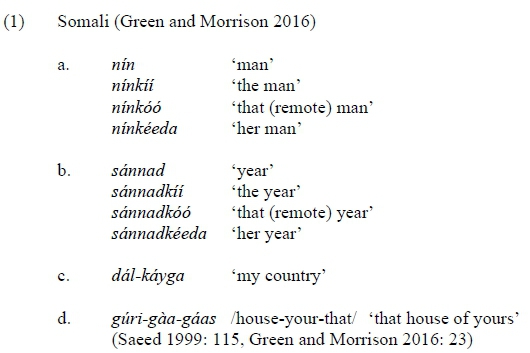
In most Cushitic languages, the tone-bearing unit is the mora. This is shown for, among others, Somali (Banti 1988: 13, Saeed 1999: 41, Green and Morrison 2016: 7) and Dhaasanac (Tosco 2001: 36). However, for Oromo, Banti (1988) and Hayward and Megerssa (1996) argue that the tone-bearing unit is the syllable and not the mora.
3.1 Tendency toward but lack of culminativity
The criterion of culminativity is not straightforward for the Cushitic grammatical-only tone languages. There is a strong tendency toward culminativity in the sense that there is seldom more than one pitch movement in a word. Languages like Iraqw and Arbore, for which nearly all lexical entries have no lexical tone, show some exceptional lexical items with tone, for example, a high tone on the last syllable. In Iraqw, this is true for a number of loans from Datooga that end in a long vowel and a voiceless stop that is optionally dropped (2a). Loans from Swahili do not show tone but have a long penultimate vowel as correlate of Swahili stress. Oromo nouns have an underlying high tone on the ultimate, or penultimate and ultimate, syllable but not two tone movements within one noun (2c). As previously mentioned, nouns can also end in a high tone by suffixation of high-tone suffixes (3).
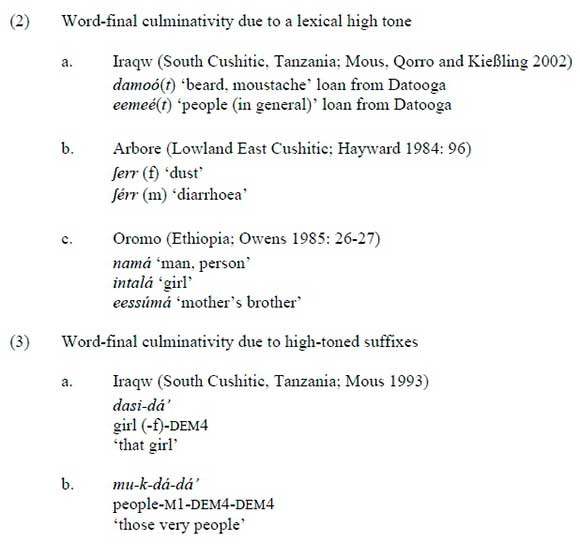
Due to suffixation with suffixes that carry a high tone, a word may end in a series of high tones. Culminativity is a concomitant coincidence in these cases rather than an organisational tendency.
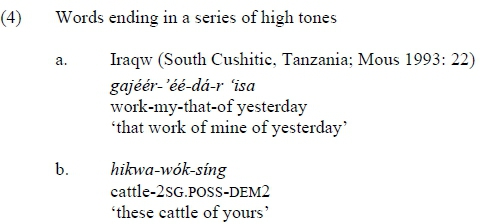
Moreover, instances with two pitch movements in a word do exist and hence there is no strict culminativity restriction in these languages. Once the tone falls in a word, it is rare that it can rise again, but it does occur. In (5a), there is a root with a high tone, with this root being long enough so that the lexical high tone is not on the ultimate syllable. This root is suffixed by a high-toned disyllabic suffix. A similar case occurs in Somali when a high-toned suffix is added to a word with a high tone on the penultimate syllable (5b). Iraqw has one loan from Datooga with a H-L-H tone pattern (5c).
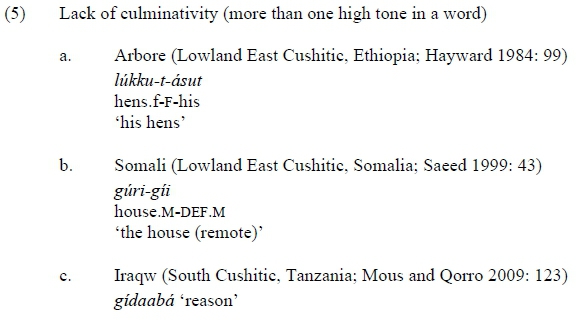
In Somali, the addition of the interrogative determiner kéé removes the high tone of the noun and of any other suffix, with the result that only the high tones on the interrogative are realised (6a-c). The same happens with compounds (6d): the rightmost noun retains the high tone. Green and Morrison (2016) analyse these as two phonological words fusing into one which results in high tone realisation on the rightmost. As a consequence, grammatically imposed tone typically occurs word-finally.
Green and Morrison (2016) analyse the instances with two tones in one orthographic word as consisting of one phonological phrase but two phonological words. In this analysis, there is never more than one high tone in a phonological word and a high tone is culminative. They note that toneless words can occur in some types of topicalisation or in certain verbal contexts (Green and Morrison 2016: 4). Le Gac (2003) proposes that a low tone is used in Somali to mark focalisation and this low tone may remove high tones.

Signs of a tendency toward culminativity are arguably processes that prevent lowering after a high tone, or displacements of high tones to form a cluster, or any process that leads to one (series of) highs and avoids a situation of two highs separated by a low. An example of such a tendency for culminativity can be seen in Oromo, where a high tone on the penultimate syllable of a root requires the ultimate syllable also to be high, as in (7a). Oromo's tone window is only two syllables. In a similar vein, Arbore reduces the number of high tones on a noun to one if an exceptional high-toned noun combines with a high-toned modifying possessive suffix, as in (7b).

Other languages - Iraqw, for example - do not show such processes. Culminativity seems not to be a crucial parameter for most Cushitic languages but culminativity tendencies can be observed in some. Series of highs do occur but analysing them as a realisation of one high is pointless if they arise from a concatenation of suffixes that happen to be high, as in Iraqw. In addition, H-L-H melodies do occur, at least in Somali, Arbore, and Iraqw. Oromo, however, does show a tendency toward a culminative high via the requirement that a high is not followed by a low if on the penultimate mora, and by the shift to avoid a series of three highs.
3.2 Demarcation: The edge of the word
Stress is typically demarcative in the sense that placement is commonly regulated in relation to the edge of the word. A high tone in Cushitic languages tends to fall on the final syllable(s) of the word. None of the Cushitic languages have examples demonstrating that tone is distinctive on every syllable of the word - tone is mainly distinctive on the final syllable(s). For Somali, Saeed (1999: 42) distinguishes three accentual patterns or melodies: high on the last mora and low elsewhere, high on the penultimate and low elsewhere, and low on all moras. Oromo has a high tone on the ultimate or penultimate syllable of a root, but if it falls on the penultimate, then the ultimate is also high. Most Oromo suffixes that end in a long vowel impose a high tone on the preceding syllable, resulting in words that end in H-H. This strong tendency toward high tones to occur on the final tone-bearing units can be seen as a stress-like feature of Cushitic languages. On the other hand, lexicalisation of high-toned suffixes will automatically lead to tones being word-final.
The preference for the final syllable is less clear for tonally distinguished verbal paradigms. In Rendille, most verbal paradigms are low-toned but concessives have a H-HL tone pattern on the final two syllables (Pillinger 1989: 236). In Arbore, tone is on different syllables of the word in the verbal paradigms - see (8) with verbal forms of dur 'to dance' displaying tone differences.
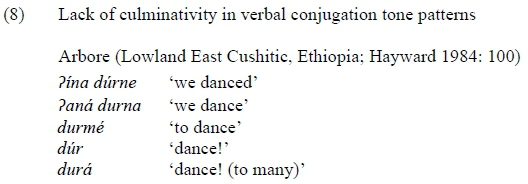
This is also true for the stress features in the Highland East Cushitic stress languages. For example, Kambaata shows the minimal pairs Paassú 'to give' versus Páassu 'may he give' (Treis 2008: 52). Furthermore, the stress on the inflected noun can occur on any syllable, as in (9).

3.3 Tone behaviour, tone rules
Since tone is primarily grammatical, it is either on the grammatical morpheme or on the syllable preceding the suffix, or the tonal pattern is itself the grammatical morpheme. The Oromo nominal plural marker requires the syllable preceding it to become high. Thus magalaa-'-lée - magaláalée 'markets', and similarly for the adjectival plural markers '-áa and -óo (see Owens 1985: 93-94). This is due to the restriction that if the penultimate mora is high then the ultimate mora is high. These suffixes can be seen as containing an initial floating high. Another way of looking at them is by considering them as imposing the penultimate accent on the word, reminiscent of the accent-determining and accent-neutral suffixes in Hausa (Newman 1986).
Some of the properties of tone in Cushitic languages are remarkable from the perspective of African tone languages. One of the recurrent properties is a high-toned suffix that lowers all preceding high tones. In Beja, for example, the high tone of 1SG n disappears in tam-a-n-ee-'k 'if I ate'; compare with tam-a-'n 'I ate' (Hudson 1976: 101-102). In many Cushitic languages, the addition of a high-toned interrogative suffix removes all preceding high tones, e.g. Somali gúri-kée - gurigée /house-which?:M/ 'which house' (Saeed 1999: 43). This is also the case for Iraqw and Alagwa (Mous 1993, 2016), and it could well be a phonologized intonational pattern. Other prosodic operations of tone occur in the noun phrase in Borana-Oromo, where a head noun must be all low when followed by a modifier (Owens 1980: 181).
While lowering all preceding syllables in a domain resembles intonational effects, this is not the case for the grammatical tone that lowers only one high tone preceding the suffix. The possessive suffixes in Arbore remove any immediately preceding high tone but not high tones that are separated by a toneless syllable or vowel, e.g. buurú-h-ásut /porridge-M-his/ - buuruhásut 'his porrridge', but lúkku-t-ásut /hens-F-his/ - lúkkutásut 'his hens' (Hayward 1984: 98-99).
The Alternating Tone Rule in Oromo changes the tone on the initial syllable of certain words into the opposite tone of the last syllable of the preceding word (see Owens 1980: 171ff, 1985: 44ff). These are uncommon rules in the canonical tone languages. In elicitation on Iraqw tone, I noticed that speakers may realise a low tone as high in order to emphasize that the final tone is low.
Tonal realisation rules are at times deviant from what one finds in canonical tone languages and these properties may be reminiscent of stress properties. However, they can be understood in light of the primarily grammatical property of tone. If high tones stem from suffixes, these tones have maximal distinctiveness if different from the preceding syllable.
4. Emerging lexical distinctions
In some Cushitic languages, lexical tone distinctions developed out of regular tonal stress placement and subsequent syllable reduction. Pillinger (1989) argues that Rendille developed from tone to accent. In terms of historical development of tone/accent systems, Appleyard (1991) has proposed that Highland East Cushitic lost its tone, while Kießling (2002, 2004) has shown how high tone (partly) developed in South Cushitic.
4.1 Gender
In Somali and Rendille, there are a number of tonal minimal pairs that reflect a difference in gender. For Rendille, Oomen (1981: 39-43) showed how this difference came about as lexicalisation of a grammatical gender suffix. Pre-Rendille was characterised by general tone assignment the on penultimate mora and a gender suffix. This was reinterpreted as tone difference after word-final reduction. In the first stage, all nouns had a high tone on the penultimate mora and the feminine suffix -et was added to feminine nouns. Hence, the feminine nouns had a high tone on the second syllable of the root while the masculine nouns without a suffix had a high tone on the first syllable. After erosion of the final syllable, the gender difference was only reflected in a different tone pattern, as in (10b).
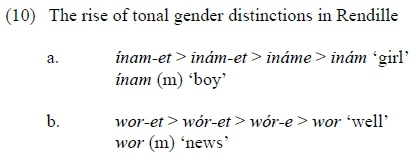
4.2 Naming
Lexical minimal pairs in tone exist in Iraqw and other South Cushitic languages but only marginally so, and partly because of a tone rule that derives names. For example, in Iraqw there are minimal pairs such as konkomo 'rooster' and konkomó 'bean podborer', and iooro 'foam' and iooró 'praying mantis'. These words for insects show qualities of names (Mous 1993: 21). Konkomó is named after the rooster because the insect eats beans like a rooster does, and the íooró is named with reference to foam because this particular species of locust tends to produce foam. Personal names are based on normal words in Iraqw but some of these names differ from their corresponding regular word by having a word-final high tone, as in (11).

Strikingly, in Iraqw, all definite nominal suffixes (possessives, demonstratives) are high toned, whereas the only nominal suffix that is not high toned is indefinite (specific; Mous 1993: 21).
4.3 Tone in closed sets of function words and grammatical categories
In Somali, lá 'with' and la 'one, someone' and ku 'you' and kú 'in' differ in tone only (Saeed 1999: 42-43). These tonal differences are due to the fact that adpositional particles such as lá 'with' and kú 'in' have a high tone, and tone is linked to this grammatical category. In Oromo, the three participial suffixes - present, completive, and concurrent - are high toned (Owens 1980: 167).
Recurrently, a paradigm is tonally uniform. This was mentioned for certain verbal paradigms in section 3.2, and for a paradigm of affixes in section 4.2. It also happens in closed sets of function words such as the Somali adpositional particles. Another example is Iraqw numerals, 1 to 9, which all end in a high tone, and the same occurs for question words (Mous 1993: 118, 120).
5. Summary and conclusions
Many Cushitic languages are not stress languages because there is no culminativity. In fact, many lexemes have no prominence nor high tone, yet they are tone languages as per Hyman's (2006) definition. The properties of tone in these languages are more reminiscent of those of stress languages, with tendencies toward culminativity and demarcation, and with rules of tone lowering of preceding syllables. However, these tendencies can best be understood by the property that is most characteristic of the Cushitic languages in question, namely that tone has a grammatical function rather than a lexical one. I therefore suggest including the function of tone, whether lexical or grammatical, when characterising tone languages.
References
Appleyard, D. 1975. A descriptive outline of Kemant. Bulletin of the School of Oriental and African Studies 38: 316-350. https://doi.org/10.1017/s0041977x0014248x [ Links ]
Appleyard, D. 1991. The role of tone in some Cushitic languages. York Papers in Linguistics 15: 5-32. [ Links ]
Banti, G. 1988. Two Cushitic systems: Somali and Oromo nouns. In N. Smith and H. van der Hulst (eds.) Autosegmental studies in pitch accent. Dordrecht: Foris. pp. 11-49. https://doi.org/10.1515/9783110874266.11 [ Links ]
Biber, D. 1982. Accent in the central Somali nominal system. Studies in African Linguistics 13(1): 1-10. [ Links ]
Crass, J. 2005. Das K'abeena: Deskriptive Grammatik einer hochlandostkuschitischen Sprache. Cologne: Rüdiger Köppe Verlag. https://doi.org/10.15460/aethiopica.8.1.359 [ Links ]
Darmon, C. 2015. A Morphosyntactic Description of Xamtanga: An Agaw (Central Cushitic) Language of the Northern Ethiopian Highlands. Unpublished doctoral dissertation, Université Lumière Lyon 2. [ Links ]
Dawit Tilahun Jembere. 2019 A Grammar of Gede'o, A Highland East Cushitic Language. Unpublished doctoral dissertation, Addis Ababa University. [ Links ]
Esser, O. 1991. Struktur, Realisation und Einsatz eines phonetisch-orientierten Datenbanksystems, ein System zur Erfassung, Verarbeitung und Auswertung akustisch-phonetischer und linguistischer Daten auf dem PC under Einbeziehung vernakulärsprachliger Korpora. Unpublished doctoral dissertation, University of Cologne. [ Links ]
Green, C.R. and M.E. Morrison. 2016. Somali wordhood and its relationship to prosodic structure. Morphology 26(1): 3-32. https://doi.org/10.1007/s11525-015-9268-x [ Links ]
Gussenhoven, C. 2004. The phonology of tone and intonation. Cambridge: Cambridge University Press. https://doi.org/10.1017/s0022226705263636 [ Links ]
Harvey, A.D. 2018. The Gorwaa Noun Phrase: Toward a Description of the Gorwaa Language. Unpublished doctoral dissertation, University of London. [ Links ]
Hayward, D. [R.J.] 1984. The Arbore language: A first investigation including a vocabulary. Hamburg: Helmut Buske. [ Links ]
Hayward, R.J. 1991. Tone and accent in the Qafar noun. York Papers in Linguistics 15: 117-137. [ Links ]
Hayward, R.J. and G. Megerssa 1996. Nominal tone in Western Oromo. In R.J. Hayward and I.M. Lewis (eds.) Voice and power. London: SOAS. pp. 21-36. [ Links ]
Hetzron, R. 1997. Awngi [Agaw] phonology. In A.S. Kaye (ed.) Phonologies of Asia and Africa, Volume 1. Winona Lake: Eisenbrauns. pp. 477-491. [ Links ]
Hudson, R.A. 1973. Syllables, moras and accents in Beja. Journal of Linguistics 9(1): 53-63. https://doi.org/10.1017/s0022226700003534 [ Links ]
Hudson, R.A. 1976. Beja. In M.L. Bender (ed.) The non-Semitic languages of Ethiopia. East Lansing, MI: African Studies Center, Michigan State University. pp. 97-132. https://doi.org/10.1017/s0021853700027663
Hyman, L.M. 1981. Tonal accent in Somali. Studies in African Linguistics 21(2): 169-203. [ Links ]
Hyman, L.M. 2006. Word-prosodic typology. Phonology 23(2): 225-257. https://doi.org/10.1017/s0952675706000893 [ Links ]
Hyman, L.M. and W.R. Leben. 2020. Tone systems. In C. Gussenhoven and A. Chen (eds.) The Oxford handbook of language prosody. Oxford: Oxford University Press. pp. 45-65. https://doi.org/10.1093/oxfordhb/9780198832232.013.6 [ Links ]
Joswig, A. 2006. The Phonology of Awngi. Ms. Addis Ababa: SIL Ethiopia. [ Links ]
Joswig, A. 2009. Rethinking Awngi tone. In S. Ege, H. Aspen, Birhanu Teferra and Shiferaw Bekele (eds.) Proceedings of the 16th International Conference of Ethiopian Studies, Volume 3. Trondheim: NTNU. pp. 1417-1425. https://doi.org/10.15460/aethiopica.16.L713 [ Links ]
Kawachi, K. 2007. A Grammar of Sidaama (Sidamo), a Cushitic Language of Ethiopia. Unpublished doctoral dissertation, The State University of New York at Buffalo. [ Links ]
Kießling, R. 1994. Eine Grammatik des Burunge. Hamburg: Research and Progress Verlag. [ Links ]
Kießling, R. 2002. Die Rekonstruktion der südkuschitischen Sprachen (West-Rift): Von den systemlinguistischen Manifestationen zum gesellschaftlichen Rahmen des Sprachwandels. Cologne: Rüdiger Köppe Verlag. [ Links ]
Kießling, R. 2004. Tonogenesis in Southern Cushitic (Common West Rift). In R.-J. Anyanwu (ed.) Stress and tone - The African experience. Cologne: Rüdiger Köppe Verlag. pp. 141-163. [ Links ]
Le Gac, D. 2003. Tonal alternations in Somali. In J. Lecarme (ed.) Research in Afroasiatic grammar 2. Amsterdam: John Benjamins. pp. 287-304. https://doi.org/10.1075/cilt.241.15gac [ Links ]
Lloret, M.-R. 1987. The morphophonology of the causative in Oromo. JALL 9(2): 141-156. [ Links ]
Mous, M. 1993. A grammar of Iraqw. Hamburg: Helmut Buske. [ Links ]
Mous, M. 2012. Cushitic. In Z. Frajzyngier and E. Shay (eds.) The Afroasiatic languages. Cambridge: Cambridge University Press. pp. 342-422. [ Links ]
Mous, M. 2016. Alagwa grammar, lexicon and texts. Cologne: Rüdiger Köppe Verlag. [ Links ]
Mous, M. and M. Qorro. 2009. Loanwords in Iraqw, a Cushitic language of Tanzania. In M. Haspelmath and U. Tadmor (eds.) Loanwords in the world's languages: A comparative handbook. Berlin: Mouton de Gruyter. pp. 103-123. https://doi.org/10.1515/9783110218442.103 [ Links ]
Mous, M., M. Qorro and R. Kießling. 2002. An Iraqw-English dictionary. Cologne: Rüdiger Köppe Verlag. [ Links ]
Newman, P. 1986. Tone and affixation in Hausa. Studies in African Linguistics 17(3): 249-267. [ Links ]
Oomen, A. 1981. Gender and plurality in Rendille. AAL 8(1): 35-75. [ Links ]
Orkaydo, O.O. 2013. A grammar of Konso. Utrecht: LOT Publications. [ Links ]
Owens, J. 1980. Observations on tone in the Booran dialect of Oromo (Galla). African Language Studies 17: 141-196. [ Links ]
Owens, J. 1985. A grammar of Harar Oromo (Northeastern Ethiopia): Including a text and a glossary. Hamburg: Helmut Buske. [ Links ]
Palmer, F.R. 1960. An outline of Bilin phonology. In Atti del Convengo Internazionale di Studi Etiopici (Roma, 2-4 Aprile 1959). Rome: Accademia Nazionale dei Lincei. pp. 109-116. https://doi.org/10.1017/s0041977x00074371 [ Links ]
Pike, K.L. 1948. Tone languages: A technique for determining the number and type of pitch contrasts in a language, with studies in tonemic substitution and fusion. Ann Arbor, MI: University of Michigan Press. https://doi.org/10.2307/1156506
Pillinger, S. 1988. Tone and accent in Rendille: A preliminary investigation. In M. Bechhaus-Gerst and F. Serzisko (eds.) Cushitic - Omotic: Papers from the International Symposium on Cushitic and Omotic Languages, Cologne, January 6-9, 1986. Hamburg: Helmut Buske. https://doi.org/10.15460/aethiopica.12.L127 [ Links ]
Pillinger, S. 1989. Accent, Tone and Prosodic Structure in Rendille, with Particular Reference to the Nominal System. Unpublished doctoral dissertation, University of London. [ Links ]
Saeed, J.I. 1999. Somali. Amsterdam: John Benjamins. [ Links ]
Sasse, H.-J. 1981. Die kuschitischen Sprachen. In B. Heine, Th. C. Schadeberg and E. Wolff (eds.) Die Sprachen Afrikas, Teil II. Hamburg: Helmut Buske. pp. 187-215. https://doi.org/10.2307/1160413 [ Links ]
Schneider-Blum, G. 2007. A grammar of Alaaba, a Highland East Cushitic language of Ethiopia. Cologne: Rüdiger Köppe Verlag. https://doi.org/10.15460/aethiopica.13.L81 [ Links ]
Tesfaye, B.A. 2015. A Descriptive Grammar of Burji. Unpublished doctoral dissertation, Addis Ababa University. [ Links ]
Tosco, M. 2000. Cushitic overview. Journal of Ethiopian Studies 33(2): 87-121. [ Links ]
Tosco, M. 2001. The Dhaasanac language. Cologne: Rüdiger Köppe Verlag. [ Links ]
Treis, Y. 2008. A grammar of Kambaata. Part 1: Phonology, nominal morphology, and non-verbal predication. Cologne: Rüdiger Köppe Verlag. https://doi.org/10.15460/aethiopica.13.L80 [ Links ]
Wedekind, K. 1980. Sidamo, Gedeo (Derasa), Burji: Phonological differences and likenesses. Journal of Ethiopian Studies 14: 131-176. [ Links ]
Wedekind, K., C. Wedekind and A. Musa. 2007. A learner's grammar of Beja (East Sudan): Grammar, texts and vocabulary (Beja-English andEnglish-Beja). Cologne: Rüdiger Köppe Verlag. https://doi.org/10.15460/aethiopica.12.L128 [ Links ]
Welmers, W.E. 1973. African language structures. Berkeley/Los Angeles: University of California Press. [ Links ]
Zelealem Leyew. 2003. The Kemantey language: A sociolinguistic and grammatical study of language replacement. Cologne: Rüdiger Köppe Verlag. [ Links ]














